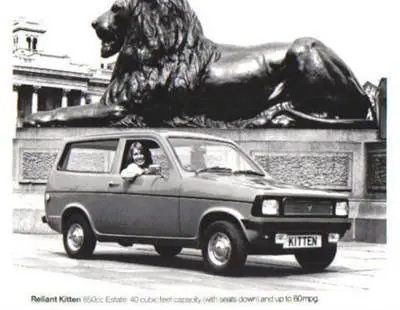Do You Remember the Reliant Kitten?
12 July 2017
Many of us have been nearly bored to death by various jokes concerning that mythical car, the ‘Robin Reliant’. Firstly, it was and is a Reliant Robin - just as you would not refer to a ‘Cortina Ford’ or ‘Chevette Vauxhall – and secondly, the Tamworth company did not lack for ambition with their small cars during the 1970s.

The Earls Court Motor Show of 1975 marked the debut of the Reliant Kitten which was designed for Robin and Regal owners who wished to progress to four-wheeled transport and to serve as a replacement for the 1964-1973 Rebel. It also had to appeal to any non-Reliant enthusiast who was seeking an urban run-around or indeed any Bond Bug driver who now required more space. Despite its diminutive looks, the Kitten was nearly a foot longer than the Mini, Robin’s aluminium 848cc OHV engine was relocated to allow more cabin space and the front suspension was via double wishbones. The standard equipment included a solitary fresh air vent and a reclining driver’s seat (an adjustable passenger seat backrest was extra) while a new grille helped to distinguish the Kitten from its three-wheeled counterpart.
However, one problem was that the Kitten was not especially cheap - at a price of £1,499.35 it was £250 more expensive than a Mini 850 and cost £200 more than a Ford Escort Popular. The new Reliant also had to compete against a variety of FWD hatchbacks and when Car magazine tested a Kitten opposite a five-door Peugeot 104 they did not wax lyrical. ‘Diabolical gear lever’…’the ride is grim’ and ‘one of the least satisfactory cars we’ve ever encountered’ were three choice phrases.
Yet, had the Kitten cost nearer £1,000 than £1,500 its virtues may have been more apparent. Its acceleration was impressive, the Ogle-designed GRP body with its hatchback rear window looked reasonably contemporary and the turning circle was a mere 24 feet. The fuel economy was remarkable – Reliant marketed the Kitten as the ’57.5 mpg car’ – and the 1976 De Luxe model came with improved instrumentation and a more comfortable interior.

For those who needed to convey a family plus luggage the Kitten estate was probably the best option; the saloon’s accommodation is best described as ‘compact and bijou’. Reliant claimed that station wagon offered ’60 mpg, 80 mph 4 seats and no rotting excuses’ – a clever reference to the merits of Reliant a fibreglass body at a time when some UK cars seemed to corrode within months.
Unfortunately, the Kitten was soon to face strong local competition; the British market Fiestas appeared in 1977 and three years later British Leyland introduced the Mini Metro. Production ceased in 1982 after just 4,551 units when it was replaced by the Fox utility and the Kitten’s design was sold to Sipani Automobiles of Bangalore where it was sold as the ‘Dolphin'. I can only vaguely recall seeing examples of the Kitten when it was new – Robins and indeed Regals were far more common sights – and today they are a testament to a manufacturer that never lacked for ambition. Sales of the Kitten may have been limited but you have to applaud the boldness of a small firm in daring to challenge the might of BL, Fiat or Renault.
